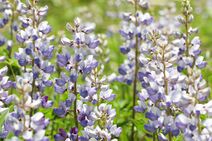Lupinus perennis
| Lupinus perennis | |
 | |
| Light: | |
| Moisture: | |
| Hardiness: | 4 |
| Soil pH: | 5.6-7.3 |
| Height: | 2' |
| Blooms: | Early Summer-Mid Summer |
| Native to: | |
| Nitrogen Fixer Nectary | |
| Edible Rating: | |
| Medicinal Rating: | |
| Tea: | Yes |
Lupinus perennis (common names: sundial lupine and wild lupine)
Propagation: Pre-soak the seed for 24 hours in warm water and then sow in early spring in a greenhouse. Germination should take place within a couple of weeks. When they are large enough to handle, prick the seedlings out into individual pots and plant them out in early summer.
It should also be possible to sow the seed outdoors in situ in the middle of spring. It might be necessary to protect this sowing from mice.
Division in early March[1]. Difficult.
Basal cuttings in April[1]. Harvest the shoots when they are about 10cm long with plenty of underground stem. Pot them up into individual pots and keep them in light shade in a cold frame or greenhouse until they are rooting well. Plant them out in the summer.
Cultivation: An easily grown plant, succeeding in any moderately good soil in a sunny position[2]. Grows well in a poor sandy soil[3]. Requires an acid to neutral soil[2].
Plants are hardy to about -25°c[3].
This species is very susceptible to slug damage.
This species has a symbiotic relationship with certain soil bacteria, these bacteria form nodules on the roots and fix atmospheric nitrogen. Some of this nitrogen is utilized by the growing plant but some can also be used by other plants growing nearby[2].
Range: Eastern N. America - Maine and Ontario, west to Minnesota and south to Florida.
Habitat: Grassy places in dry sandy soils[3].
Edibility: Seed - cooked[4]. Used as a protein-rich vegetable or savoury dish in any of the ways that cooked beans are used, they can also be roasted or ground into a powder. The seed has a bitter flavour due to the presence of toxic alkaloids, it should be thoroughly leached before being cooked[5][4].
Seedpods - cooked[4].
Medicinal: A cold tea made from the leaves has been used to treat nausea and internal haemorrhages[6][7].
Pollinators: Bees
Soil: Can grow in light and medium soils.
Drainage: Prefers well drained soil.
Flower Type: Hermaphrodite
Known Hazards: The seed of many lupin species contain bitter-tasting toxic alkaloids, though there are often sweet varieties within that species that are completely wholesome[8][9]. Taste is a very clear indicator. These toxic alkaloids can be leeched out of the seed
Links
References
- ↑ 1.0 1.1 Chittendon, Fred. RHS Dictionary of Plants. Oxford University Press, 1951.
- ↑ 2.0 2.1 2.2 Huxley, Anthony. The New Royal Horticultural Society Dictionary of Gardening. MacMillan Press, 1992.
- ↑ 3.0 3.1 3.2 Phillips, Roger and Martyn Rix. Perennials - The Definitve Reference. Pan Books, 1991.
- ↑ 4.0 4.1 4.2 Tanaka, Tyōzaburō. Tanaka's Cyclopaedia of Edible Plants of the World. Keigaku Publishing, 1976.
- ↑ Hedrick, Ulysses. Sturtevant's Edible Plants of the World. Dover Publications, 1972.
- ↑ Foster, Steven and Billy Tatum. Medicinal Plants of Eastern and Central North America. Houghton Mifflin, 1990.
- ↑ Moerman, Daniel. Native American Ethnobotany. Timber Press, 1998.
- ↑ Frohne, Dietrich and Hans Pfänder. J. A Colour Atlas of Poisonous Plants. Timber Press, 1984.
- ↑ Cooper, Marion. Poisonous Plants in Britain and their Effects on Animals and Man. The Stationery Office, 1984.